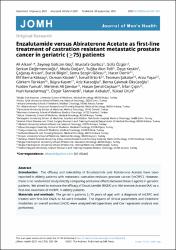| dc.contributor.author | Alkan, Ali | |
| dc.contributor.author | Güç, Zeynep Gülsüm | |
| dc.contributor.author | Gürbüz, Mustafa | |
| dc.date.accessioned | 2021-10-07T06:44:17Z | |
| dc.date.available | 2021-10-07T06:44:17Z | |
| dc.date.issued | 2021 | en_US |
| dc.identifier.citation | Ali Alkan, Zeynep Gülsüm Güç, Mustafa Gürbüz, Güliz Özgün, Serkan Değirmencioğlu, Mutlu Doğan, Tuğba Akın Telli, Özge Keskin, Çağatay Arslan, Burak Bilgin, Sema Sezgin Göksu, Hacer Demir, Elif Berna Köksoy, Osman Köstek, İsmail Ertürk, Teoman Şakalar, Arzu Yaşar, Görkem Türkkan, Büşra Kasım, Aziz Karaoğlu, Berna Çakmak Öksüzoğlu, Fulden Yumuk, Mehmet Ali Şendur, Hasan Şenol Coşkun, İrfan Çiçin, Nuri Karadurmuş, Özgür Tanrıverdi, Hakan Akbulut, Yüksel Ürün. Enzalutamide versus Abiraterone Acetate as first-line treatment of castration resistant metastatic prostate cancer in geriatric (≥75) patients. Journal of Men's Health. 2021. 17(4);128-134. | en_US |
| dc.identifier.uri | https://doi.org/10.31083/jomh.2021.041 | |
| dc.identifier.uri | https://hdl.handle.net/20.500.12809/9578 | |
| dc.description.abstract | Introduction: The efficacy and tolerability of Enzalutamide and Abiraterone Acetate have been reported in elderly patients with metastatic castration resistant prostate cancer (mCRPC). However, there is no randomized study directly comparing antitumor effects between these 2 agents in geriatric patients. We aimed to evaluate the efficacy of Enzalutamide (ENZA) and Abiraterone Acetate (AA) as a first-line treatment of mCRPC in elderly patients.
Materials and methods: The geriatric patients (>= 75 years of age) with a diagnosis of mCRPC and treated with first-line ENZA or AA were included. The impacts of clinical parameters and treatment modalities on overall survival (mOS) were analyzed retrospectively and Cox regression analysis was performed.
Results: One hundred thirty-four mCRPC patients (77 in AA, 57 in ENZA), with a median age of 81 (75-93) were analyzed. The patient and disease characteristics were similar between arms. While there were more grade 1-2 toxicities in AA arm (45.5% vs 17.5%, P = 0.001), the discontinuation due to toxicity was similar between groups (8.5% vs 5.9%, P = 0.81). The mOS was 18.0 months (95% CI, 15.2-20.7) in AA, and 20.0 months (95% CI, 4.4-35.5) in ENZA arm (P = 0.47). In multivariate analysis, high Gleason score (>= 8) (HR: 2.0 (95% CI, 1.1-3.4), P = 0.009) and high initial PSA values (>= 100 ng/mL) (HR: 2.6 (95% CI, 1.5-4.8), P = 0.001) were poor prognostic factors. The choice of AA vs ENZA was insignificant as a predictor of OS (HR: 0.87 (95% CI, 0.48-1.56), P = 0.65).
Conclusion: In the first-line treatment of mCRPC in elderly (>= 75) patients, AA and ENZA showed similar results in terms of mPFS and mOS. The clinical impacts of second-generation androgen receptor pathway inhibitors in the elderly population should be tested in prospective randomized studies. | en_US |
| dc.item-language.iso | eng | en_US |
| dc.publisher | IMR Press Limited | en_US |
| dc.relation.isversionof | 10.31083/jomh.2021.041 | en_US |
| dc.item-rights | info:eu-repo/semantics/openAccess | en_US |
| dc.subject | Metastatic castration-resistant prostate cancer | en_US |
| dc.subject | Enzalutamide | en_US |
| dc.subject | Abiraterone Acetate | en_US |
| dc.subject | Elderly | en_US |
| dc.title | Enzalutamide versus Abiraterone Acetate as first-line treatment of castration resistant metastatic prostate cancer in geriatric (>= 75) patients | en_US |
| dc.item-type | article | en_US |
| dc.contributor.department | MÜ, Tıp Fakültesi, Dahili Tıp Bilimleri Bölümü | en_US |
| dc.contributor.institutionauthor | Alkan, Ali | |
| dc.identifier.volume | 17 | en_US |
| dc.identifier.issue | 4 | en_US |
| dc.identifier.startpage | 128 | en_US |
| dc.identifier.endpage | 134 | en_US |
| dc.relation.journal | Journal of Men's Health | en_US |
| dc.relation.publicationcategory | Makale - Uluslararası Hakemli Dergi - Kurum Öğretim Elemanı | en_US |


















